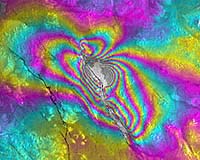| . |  |
. |
Irvine CA (SPX) Aug 26, 2010 Earthquakes have rocked the powerful San Andreas fault that splits California far more often than previously thought, according to UC Irvine and Arizona State University researchers who have charted temblors there stretching back 700 years. The findings, to be published in the Sept. 1 issue of Geology, conclude that large ruptures have occurred on the Carrizo Plain portion of the fault - about 100 miles northwest of Los Angeles - as often as every 45 to 144 years. But the last big quake was in 1857, more than 150 years ago. UCI researchers said that while it's possible the fault is experiencing a natural lull, they think it's more likely a major quake could happen soon. "If you're waiting for somebody to tell you when we're close to the next San Andreas earthquake, just look at the data," said UCI seismologist Lisa Grant Ludwig, principal investigator on the study. An associate professor of public health, she hopes the findings will serve as a wake-up call to Californians who've grown complacent about the risk of major earthquakes. She said the new data "puts the exclamation point" on the need for state residents and policymakers to be prepared. For individuals, that means having ample water and other supplies on hand, safeguarding possessions in advance, and establishing family emergency plans. For regulators, Ludwig advocates new policies requiring earthquake risk signs on unsafe buildings and forcing inspectors in home-sale transactions to disclose degrees of risk. Sinan Akciz, UCI assistant project scientist and the study's lead author, was part of a team that collected charcoal samples from carefully dug trenches in the Carrizo Plain, along with earlier samples that Ludwig had stored for decades in her garage. The charcoal forms naturally after wildfires, then is washed into the plain by rains, building up over the centuries in layers that are fragmented during earthquakes. Akciz dated the samples via recently developed radiocarbon techniques to determine time frames for six major earthquakes, the earliest occurring about 1300 A.D. The field data confirmed what Ludwig had long suspected: The widely accepted belief that a major earthquake happened on the fault every 250 to 400 years was inaccurate. Not all quakes were as strong as originally thought, either; but they all packed a wallop, ranging between magnitude 6.5 and 7.9. "What we know is for the last 700 years, earthquakes on the southern San Andreas fault have been much more frequent than everyone thought," said Akciz. "Data presented here contradict previously published reports." "We've learned that earthquake recurrence along the San Andreas fault is complex," agreed co-author Ramon Arrowsmith, a geology professor at Arizona State. "While earthquakes may be more frequent, they may also be smaller. That's a bit of good news to offset the bad." Ken Hudnut, a geophysicist with the U.S. Geological Survey, said the research is significant because it revises long-standing concepts about well-spaced, extremely strong quakes on the 810-mile fault. "I believe they've done a really careful job," he said, adding that the work was rigorously field-checked by many scientists. "When people come up with new results challenging old notions, others need to see the evidence for themselves." Upending previous San Andreas fault modeling is part of a broader shift in seismic research. Experts are increasingly tracking webs of trigger points, smaller faults and more frequent quakes rather than focusing on large, single faults where they assumed there would be well-spaced shakers. As for the 153-year hiatus since the magnitude 7.8 Fort Tejon quake, Ludwig said: "People should not stick their heads in the ground. There are storm clouds gathered on the horizon. Does that mean it's definitely going to rain? No, but when you have that many clouds, you think, 'I'm going to take my umbrella with me today.' That's what this research does: It gives us a chance to prepare." Funding for the study was provided by the National Science Foundation, U.S. Geological Survey and Southern California Earthquake Center.
Share This Article With Planet Earth
Related Links University of California, Irvine Bringing Order To A World Of Disasters When the Earth Quakes A world of storm and tempest
 Surfing For Earthquakes
Surfing For EarthquakesEdinburgh, UK (SPX) Aug 26, 2010 A better understanding of the ground beneath our feet will result from research by seismologists and Rapid-a group of computer scientists at the University of Edinburgh. The Earth's structure controls how earthquakes travel and the damage they can cause. A clear picture of this structure would be extremely valuable to earthquake planners, but it requires the analysis of huge amounts of data. ... read more |
|
| The content herein, unless otherwise known to be public domain, are Copyright 1995-2010 - SpaceDaily. AFP and UPI Wire Stories are copyright Agence France-Presse and United Press International. ESA Portal Reports are copyright European Space Agency. All NASA sourced material is public domain. Additional copyrights may apply in whole or part to other bona fide parties. Advertising does not imply endorsement,agreement or approval of any opinions, statements or information provided by SpaceDaily on any Web page published or hosted by SpaceDaily. Privacy Statement |